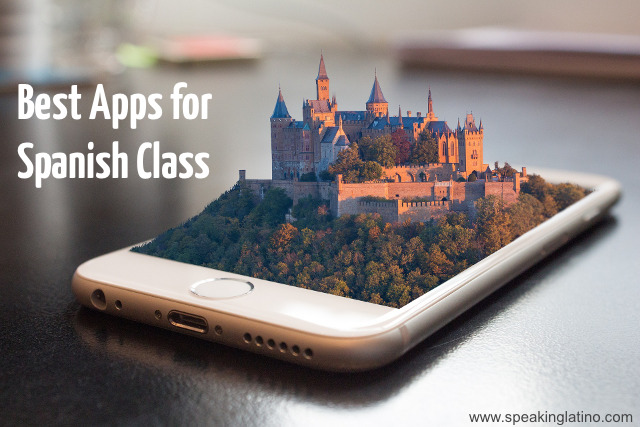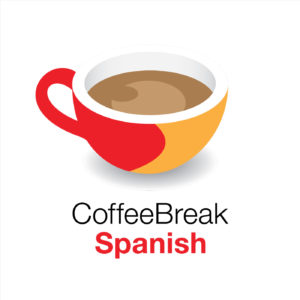
There’s never enough time in class to give your students all the practice they need.
But what if each student could have a personal tutor?
… And that’s exactly the promise of smartphone apps.
You already know that there are ~~hundreds~~ thousands of apps available for practicing Spanish. But it can be time-consuming to find the really useful ones.
In this article, I’ll give you my top recommendations, divided by skill category. (I like Paul Nation’s “four strands of learning” approach, but I’ll break it down a little further than that.)
Full disclosure: I’m not a teacher (though I do run a meetup for Spanish learners with over 400 members). I’m a cognitive psychologist and app maker. My app (SuperCoco) is among my recommendations–but that doesn’t prevent me from giving you a fair overview of the whole universe of apps. I’ll focus on apps that are free or have a generous free component.
1. Apps for listening practice
I divide apps for listening practice into extensive and intensive approaches. Not included here are apps for language partners, which are covered, below.
Extensive listening: For level-specific extensive listening, the best app is your favorite podcast app. There are many to choose from: Overcast (iOS) and Podcast Republic (Android) are two very popular, free choices.
The harder part is choosing what to listen to and/or watch.
Podcasts: There are many podcasts to choose from. These are some of the most popular. The format typically pairs a native Spanish speaker with a native English speaker.
 Coffee Break Spanish is rightfully one of the most popular podcasts among Spanish learners. The language is well controlled to level, very clear and the hosts are having a great time. Season 1 is aimed at total beginners and each subsequent season progresses in difficulty. Seasons 1 and 2 are more pedagogical, with a lot of instruction. The extensive listening really starts in Season 3, where the hosts spend more time discussing topics of culture and general interest, using the conversation as an opportunity to focus on specific language topics. Season 4 is something quite different: it tells a kind of soap opera story through texts such as diary entries, letters, etc., with each episode reading the text and the hosts discussing language topics related to it.
Coffee Break Spanish is rightfully one of the most popular podcasts among Spanish learners. The language is well controlled to level, very clear and the hosts are having a great time. Season 1 is aimed at total beginners and each subsequent season progresses in difficulty. Seasons 1 and 2 are more pedagogical, with a lot of instruction. The extensive listening really starts in Season 3, where the hosts spend more time discussing topics of culture and general interest, using the conversation as an opportunity to focus on specific language topics. Season 4 is something quite different: it tells a kind of soap opera story through texts such as diary entries, letters, etc., with each episode reading the text and the hosts discussing language topics related to it.
Level: Low B1 (Season 3) and B1-B2 (Season 4).
Language and accent: Peninsular (with occasional Latin American guests)
Advanced Spanish with Spanish Obsessed is a husband and wife team (Rob from UK / Liz from Colombia) having conversations on various topics, especially Colombia, travel and culture. What I really like about this podcast is that they frequently have guests from different countries, giving you a chance to experience a range of Spanish accents.
Level: B2
Language and accent: Latin American
Españolistos is a husband and wife team (Nate from Texas / Andrea from Colombia) having conversations on topics such as Senderismo en Latinoamérica and 15 cosas que extrañamos de Estados Unidos. Nate’s accent is a bit heavy at times, but they cover a great range of topics (abortion, politics, social issues) that you won’t find in Coffee Break Spanish, and they’re having a great time and are easy to listen to.
Level: B1-B2
Language and accent: Latin American
YouTube channels
Easy Spanish – Learn Spanish from the Streets! In this extensive series, the hosts go out on the streets of Mexico City interviewing locals on the topic of the day. Topics range from “favorite spots in D.F” to “what do millenials think of themselves”, from the “Trump wall” to “LGBQT pride parade”. The hosts are super-friendly and speak clearly, but their live interview subjects can be quite a bit more challenging to understand.
Level: B2 and above
Language and accent: Latin American (Mexican)
Intensive listening: These apps are designed to not only let you listen, but to let you study what you’re hearing. Most of these apps display a synchronized transcript that follows the audio/video content. In most cases, you can save words you don’t know for later review.
Qlipo.com is a free web site that has synchronized transcripts for Spanish pop songs. The selection of songs is small, but if you like them, it’s a delightful way to learn the words to the songs.
FluentU and Yabla are the two, big video learning apps. They provide a selection of videos at different levels, combined with transcriptions and tools for review. FluentU has a 15-day free trial and Yabla has a small selection of free sample videos.
SuperCoco (reviewed below) also provides intensive listening, since its primary methodology is learning by ear.
2. Apps for speaking practice
Both of these apps teach language in context via scripted conversations (aka dialogs). However, the approaches are very different.
SuperCoco uses a call-and-response format, so that the learner is constantly listening and speaking. It works well in hands-free mode, which enables practice while doing other things (jogging, doing chores, etc.). SuperCoco teaches new words as they arise, but it’s up to the learner if they want to drill down into any specific sentence and explore definitions or grammar. There are fifteen graded chapters (300 conversations), from Beginner to Intermediate–and you can start anywhere. Your first chapter is free (at least a month’s study); subsequent chapters require a subscription.
Mango Languages uses an instructional approach. The dialog is broken down sentence-by-sentence (and even word-by-word) and a narrator guides the student through meanings and grammar. At each point, the learner is encouraged to practice speaking the sentence and can compare with the native speaker. This approach is great for students that want more hand-holding, but it does mean that they cover less ground. The primary Spanish course contains 20 conversations (10 Beginner, 10 Intermediate). Additional units cover specialties such as medical and legal Spanish. Mango offers a two-week free trial, but many public libraries offer free access to it.
3. Apps for reading practice
Apps for reading enable the learner to import any text and have the words automatically linked to definitions. A simple tap or click reveals any word’s translation, avoiding tedious dictionary lookups. In addition, words can be saved for later review. A limitation of these apps is that the supplied meanings are often incorrect, since they are derived by machine translation. However, most apps make it convenient to reference a complete dictionary entry and correct the translation.
Readlang is one of the most popular reading apps. It has a Chrome browser extension that lets you transform any web page you’re visiting into a clickable text. However, I recommend that you import texts into the Readlang web site itself. This enables you to access not only the word-by-word translation, but the full reference dictionary; that way you can correct the words that Readlang mistranslates. Readlang is a generous freemium product; its free tier allows unlimited use, restricting only a few premium features.
Lingq is similar to Readlang, however it puts more emphasis on its built-in library of texts and courses. There is no browser extension and it’s not as straightforward to upload your own texts. Lingq is also a freemium product; however, unlike Readlang its free tier limits the amount that you can use it.
4. Apps for writing practice
Lang-8 is the go-to site for writing practice. Anyone can submit a piece of writing and get it corrected by native speakers. In exchange, you are expected to correct writing for others, in your native language. (Of course, these corrections do vary widely in quality–as many native speakers are not especially good writers.) Lang-8 is a freemium product, with some features disabled for free users.
Reddit is a community bulletin board organized by topic. It has a subreddit for “Spanish help” where one is invited to post texts for corrections. It is completely free and the quality of corrections is often excellent.
iTalki (reviewed, below) also has a section for community-based corrections of written texts.
5. Apps for language-focused learning
These are apps for language- and form-focused practice. I divide them into flashcard apps for vocabulary and apps for grammar, spelling and vocabulary development. I don’t go into detail on these apps, because I think that flashcard apps are overused, but they are very popular.
Flashcard apps
Lingvist is the thinking man’s (and woman’s) flashcard app. It’s focused entirely on language learning, with a carefully selected vocabulary list emphasizing the most useful (frequent) words. Another nice feature is that it teaches words in the context of a sentence.
 Memrise is one of the most popular flashcard apps for language learning. Unlike most of the other flashcard apps, Memrise is targeted at language learners. They have pre-made decks of cards for many languages and different levels. They also have additional features specific to language learning, however, many of their more advanced features are available only to paid subscribers.
Memrise is one of the most popular flashcard apps for language learning. Unlike most of the other flashcard apps, Memrise is targeted at language learners. They have pre-made decks of cards for many languages and different levels. They also have additional features specific to language learning, however, many of their more advanced features are available only to paid subscribers.
Anki and Quizlet are also quite popular. They are more general purpose than Lingvist or Memrise and also have more support for user-created content. TinyCards (from Duolingo) is a new flashcard app, with the same pleasant design and style of the Duolingo app.
Other
Duolingo is by far the most popular app for general purpose language review. The app is completely free (ad-supported) and offers a gamified interface where learners can learn some new vocabulary and practice basic grammar and sentence construction.
6. Apps for fluency practice
Although there are other ways to practice fluency, I’ll focus on apps that connect native speakers of different languages. These apps enable you to find a language partner for conversation practice. It’s up to the partners how to structure their time–and that can be a weakness. But with a good partner and some common sense in making good use of the time, this can be an invaluable opportunity for real life practice. Native English speakers learning Spanish are lucky because they’re in high demand.
There are a number of apps in this category. The most important features are: plenty of users to choose from and a good search interface to help you find a compatible partner. These apps can lean towards flirting singles, but there are lots of sincere learners on there as well.
HelloTalk gets first spot here because its search interface gives you the most options.
iTalki is one of the best-known language exchange sites. Although it has since morphed into a place for finding paid language tutors, dig down and you’ll find that the “language partners” section is still there. It does have some (limited) search options.
Tandem is a very polished language exchange app with some nice features. They’ve recently been experimenting with sharing videos of users’ actual conversations (with permission, of course). It’s an interesting idea and great to see some innovation in this space. I wish they had better search options for finding partners.
This was a guest post by Phil Mitchell, the creator of the SuperCoco app, which teaches Spanish through conversations.